At a glance
H5N1 bird flu is caused by viruses that can infect cows and other animals but most commonly affect birds and poultry. People who work with infected animals or their byproducts (for example, raw milk), might get sick from the virus. For example, dairy and poultry workers might get sick with H5N1 bird flu. Your employer should develop a workplace health and safety plan and share it with you. CDC updated this page to add information about worker exposure levels (low, medium, and high). We also added detail about how to use the right personal protective equipment safely for each exposure level.
Overview
The H5N1 bird flu viruses have been spreading among dairy cows in multiple U.S. states. Scientists have found high levels of virus in the milk of infected dairy cows. We have also found H5N1 viruses that cause bird flu in:
- Poultry flocks
- Wild birds
- Some mammals, including cats
- Lung, muscle, udder tissue and internal organs of infected dairy cows
Different animals with H5N1 bird flu may show different signs of illness. The infection is often fatal in poultry. Cows typically experience mild illness. They may have signs of illness such as lack of appetite, nasal discharge, decreased milk production, and abnormal milk (thickened or discolored).
Although H5N1 viruses usually do not infect people, there have been some sporadic cases of human infection. H5N1 bird flu in people has been mild to severe, including death. The signs and symptoms of H5N1 bird flu are varied. People with H5N1 can have red and irritated eyes, called conjunctivitis. They can also have a fever or cough. Sometimes people sick with H5N1 bird flu also get pneumonia, which is an infection of the lungs. If you work with animals, raw milk, or other materials that could be infected or contaminated, your employer should take steps to reduce your exposure. This includes providing you with personal protective equipment (PPE) to use in certain situations and training on how to use it safely.
CDC has identified work tasks and settings that may expose you to viruses that cause H5N1 bird flu. These tasks and settings range from low to high exposures. The type of personal protective equipment you should wear depends on the exposure level.
Example work tasks and exposure levels include:
- High exposures:
- Work in milking parlors on farms with animals infected with H5N1 viruses (affected farms)
- Work with sick or dead animals on a farm with animals infected with H5N1 viruses
- Work with sick or dead birds or mammals at a zoo or other wild animal facility with animals infected with H5N1 viruses
- Work in milking parlors on farms with animals infected with H5N1 viruses (affected farms)
- Medium exposures:
- Work with healthy non-lactating animals on affected dairy farms
- Work with animals on a farm without H5N1 bird flu near other farms with H5N1 bird flu
- Work with healthy birds and mammals at a zoo or other wild animal facility affected by H5N1 bird flu
- Work with healthy non-lactating animals on affected dairy farms
- Low exposures:
- Work that does not involve direct contact with animals or their secretions
- Work with animals on a farm without H5N1 bird flu when there are no animals infected with H5N1 viruses on other nearby farms
- Work with animals at a zoo or other animal facility when there are no animals infected with H5N1 viruses, regardless of infected animals in your region
- Work that does not involve direct contact with animals or their secretions
Talk with your supervisor or your employer's health and safety committee to understand your exposure levels and how to protect yourself at work.
How it spreads
These viruses could spread from animals to people in several ways:
- If you touch something contaminated with virus and touch your eyes, nose, or mouth
- If a liquid containing live virus splashes into your eyes, nose, or mouth (for example, raw cow's milk from an infected cow)
- If you eat, drink, or inhale droplets contaminated with live virus
- If you handle sick or dead animals infected with virus
Symptoms can include:
- Eye redness and irritation (conjunctivitis)
- Fever (temperature of 100°F [37.8°C] or greater) or feeling feverish
- Cough
- Sore throat
- Runny or stuffy nose
- Muscle or body aches
- Headaches
- Fatigue
- Shortness of breath or difficulty breathing
Less common signs and symptoms include diarrhea, nausea, vomiting, or seizures.
Prevention steps and strategies
When you are working in medium and high exposure settings you should use PPE. If you are not wearing PPE in these settings, avoid direct or close physical contact with:
- Any animals that are or might be sick, including birds, dairy cows, cats, and other livestock. Also avoid contact with:
- Feces, urine, or litter from these animals
- Raw (unpasteurized) milk from these animals
- Feces, urine, or litter from these animals
- Any animals that have died, including birds, dairy cows, cats and other livestock
- Internal organs or udders from lactating dairy cows
- Surfaces and water (for example, ponds, waterers, buckets, pans, troughs) that might be contaminated with feces, urine, or waste milk from potentially infected animals
Wear PPE
In medium and high exposure settings, wear PPE when in contact with or around:
- Poultry
- Dairy cows
- Raw milk
- Other animals
- Surfaces and other items that might be contaminated
You may need more PPE than what you use for your normal duties. The type of PPE you need will depend on your work tasks. It will also depend on whether there are confirmed or suspected cases of H5N1 bird flu in your farm or area. Workers who have a high exposure level will require more PPE than those with medium exposure levels.
Your employer should provide the recommended PPE at no cost. Ask your supervisor if you have questions about what type of PPE to wear or when or how to use it. You should be given time to put on and remove PPE during work hours.
Protect yourself from H5N1 bird flu
Before putting on PPE
- Leave clean personal clothing and food, drinks and other items in clean areas provided by your employer.
- Follow directions from your employer for entering and leaving the worksite.
- Use separate designated areas to put on clean PPE and remove dirty PPE.
- Wash your hands for 20 seconds with soap and water or, if not available, use an alcohol-based hand sanitizer.
While wearing PPE
- Avoid touching yourself above your chest, especially your eyes, mouth, or nose. This is especially important to avoid doing after touching any contaminated material.
- Do not eat, drink, touch your phone, smoke, vape, chew gum, dip tobacco, or use the bathroom.
- Work in pairs and pay close attention to your surroundings for hazards such as animal movement.
- Take steps to protect yourself from heat stress.
- Learn the symptoms and risk factors, first aid, and ways to prevent heat-related illness.
- Work in pairs and observe each other for signs of heat-related illness.
- Take frequent breaks to rest and hydrate in a cool clean area after removing dirty PPE. This is important because removing PPE to take a drink while you are still working could expose you to virus that could make you sick.
- Stay hydrated. Avoid alcohol and drinks with high caffeine or sugar.
- Understand how certain medicines may increase the risk of heat-related injury and talk to a healthcare worker for help.
- Learn the symptoms and risk factors, first aid, and ways to prevent heat-related illness.
Removing PPE
- Remove PPE before entering any clean areas including restrooms, breakrooms, and administrative areas.
- Set aside reusable PPE for cleaning and disinfection. Throw away disposable PPE according to your employer's guidance.
After removing PPE
- Clean and disinfect reusable PPE based on guidance from your employer.
- Shower at the end of the work shift and put on clean clothing. If there are no showers at work, clean up as much as possible, put on clean clothing, and shower immediately when you get home.
- Leave all contaminated clothing and equipment at work to be cleaned.
- Observe your health daily, even if you followed all instructions for wearing PPE. Monitor for any new symptoms of illness while working with confirmed or potentially infected animals, byproducts, or surfaces and during the 10 days after your last exposure:
- Stay home and stay away from others as much as possible until you know whether you have H5N1 bird flu.
- If you develop symptoms, tell your supervisor and healthcare provider, and they will help you contact your state or local health department.
- Your health department will help you determine what to do next and may test you for H5N1 bird flu.
- If you have H5N1 bird flu, stay home and away from others until you feel better.
- A healthcare provider may prescribe medication that is used to prevent and treat flu (antiviral medication). It is important to follow the directions for taking the medication.
Know how to use PPE
The graphics below show how to wear PPE, put on PPE, and remove PPE in different settings.
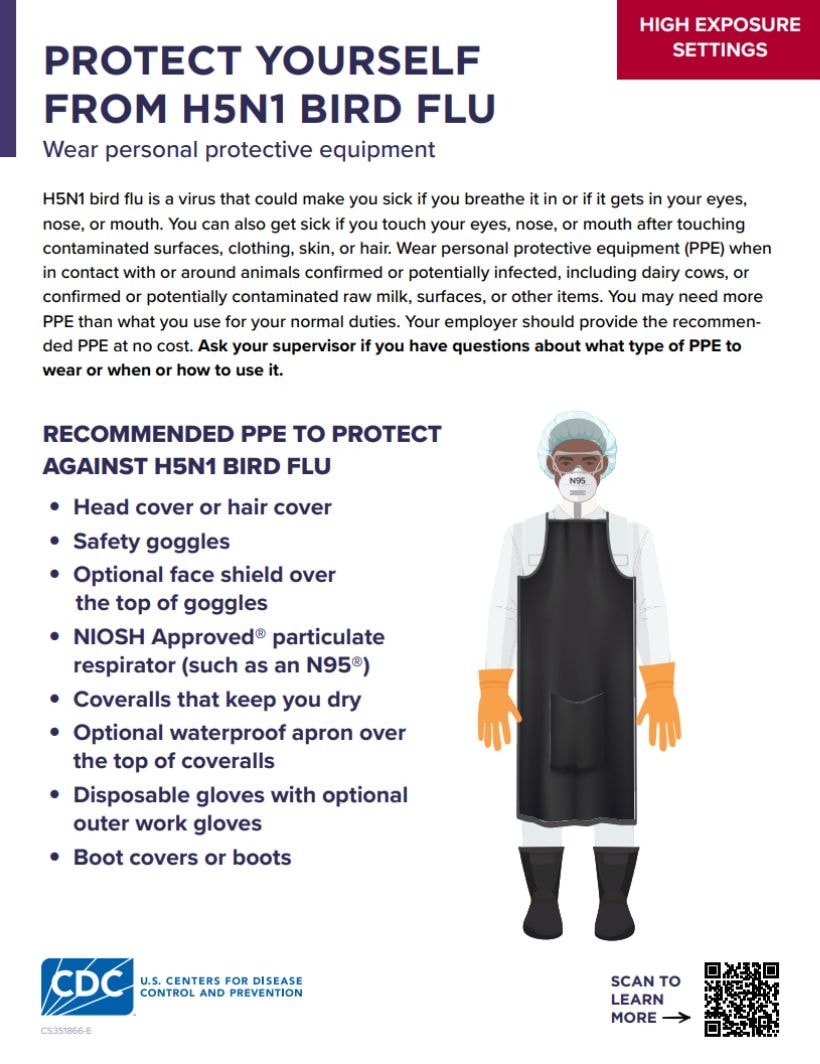
Wear Personal Protect Equipment – High Exposure
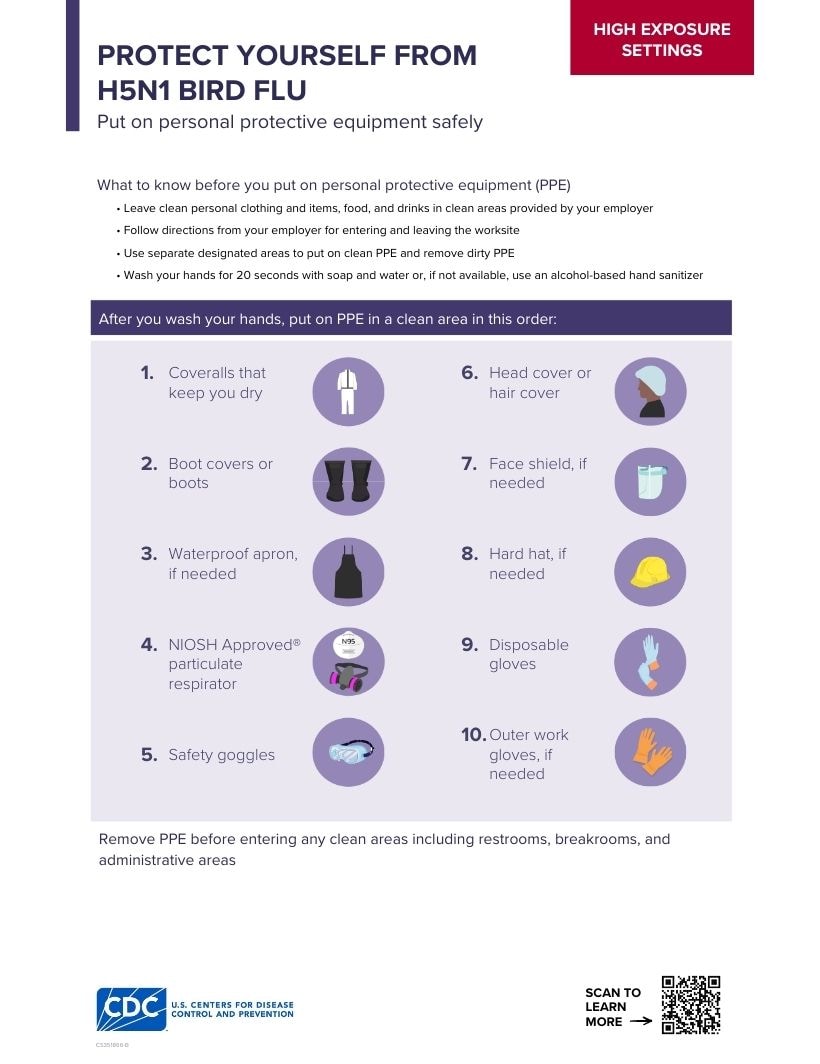
Put On Personal Protective Equipment Safely – High Exposure
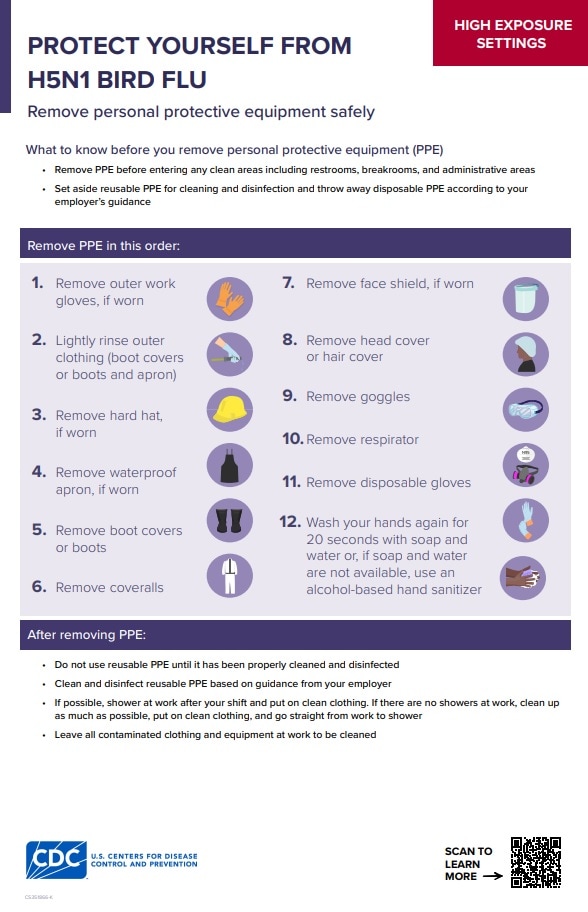
Remove Personal Protective Equipment Safely – High Exposure
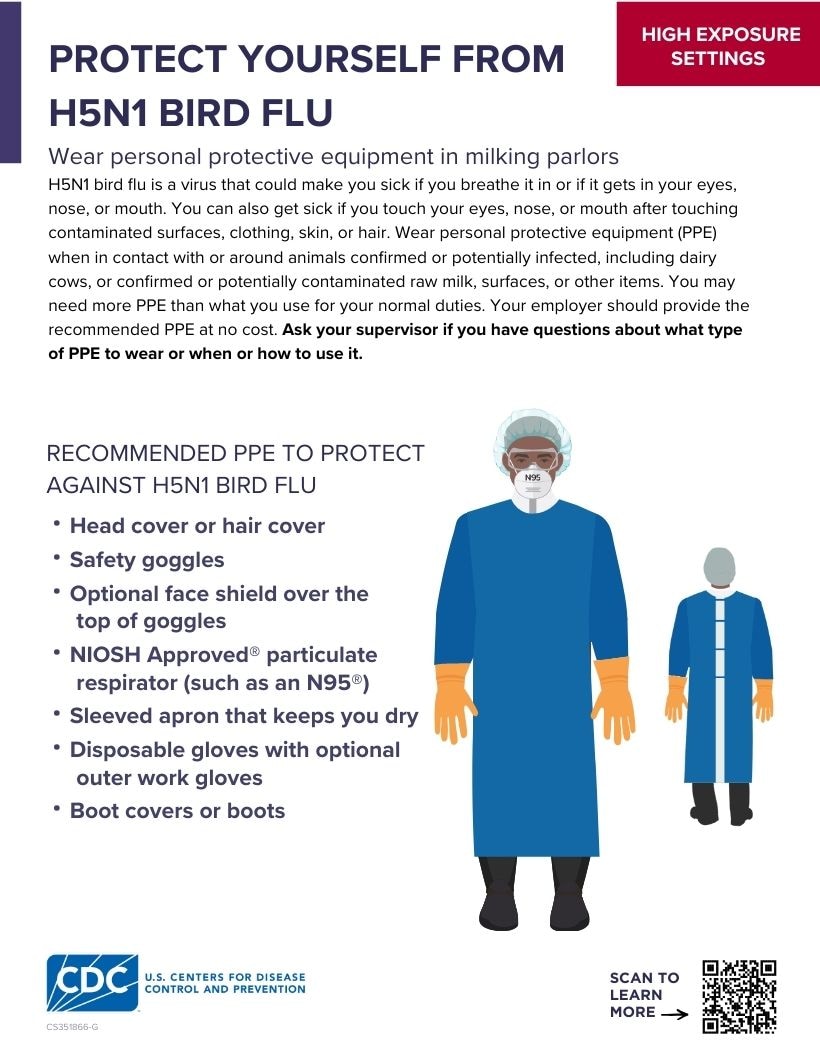
Wear Personal Protect Equipment – High Exposure for Milking Parlor
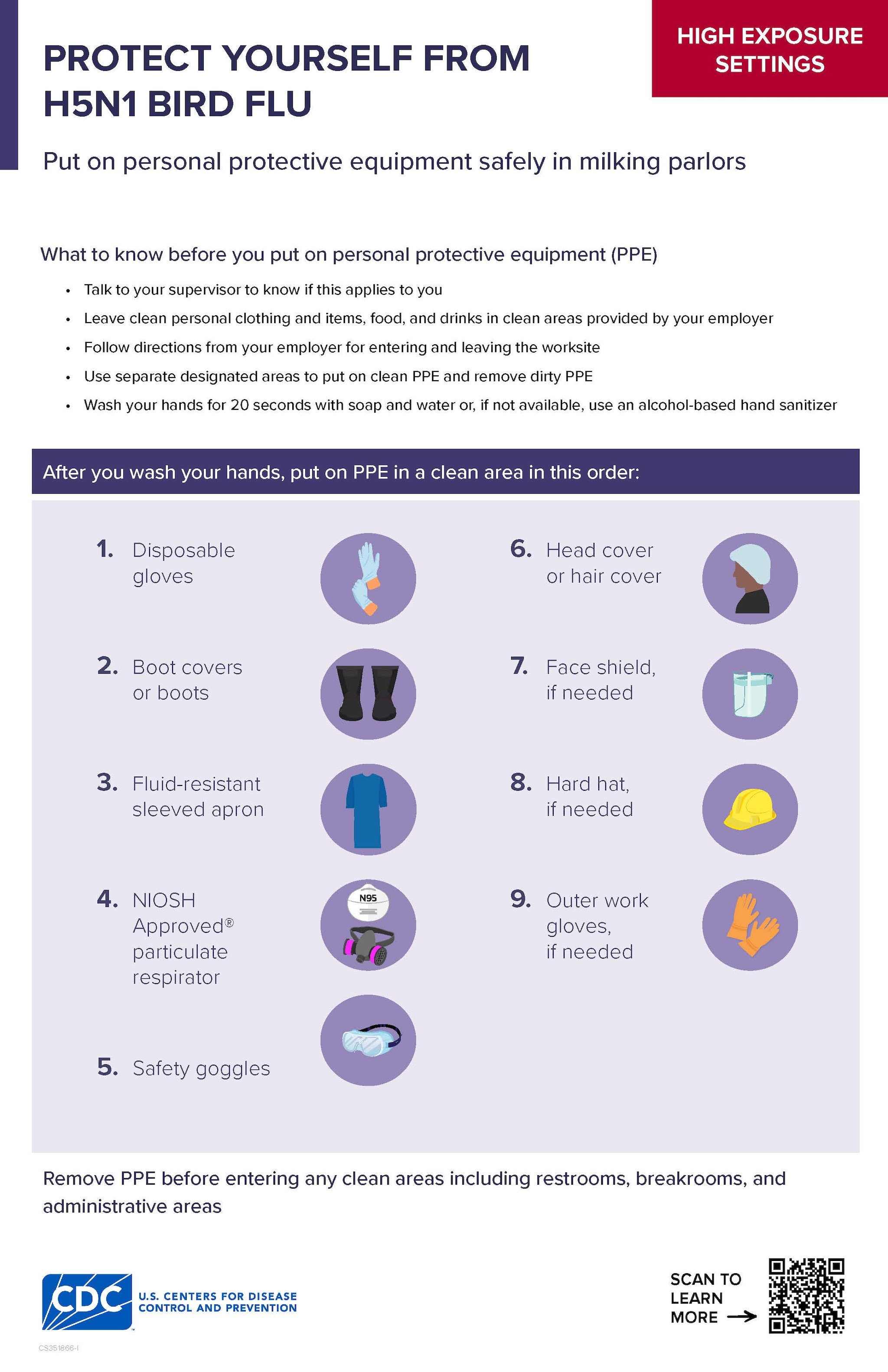
Put On Personal Protective Equipment Safely – High Exposure for Milking Parlor
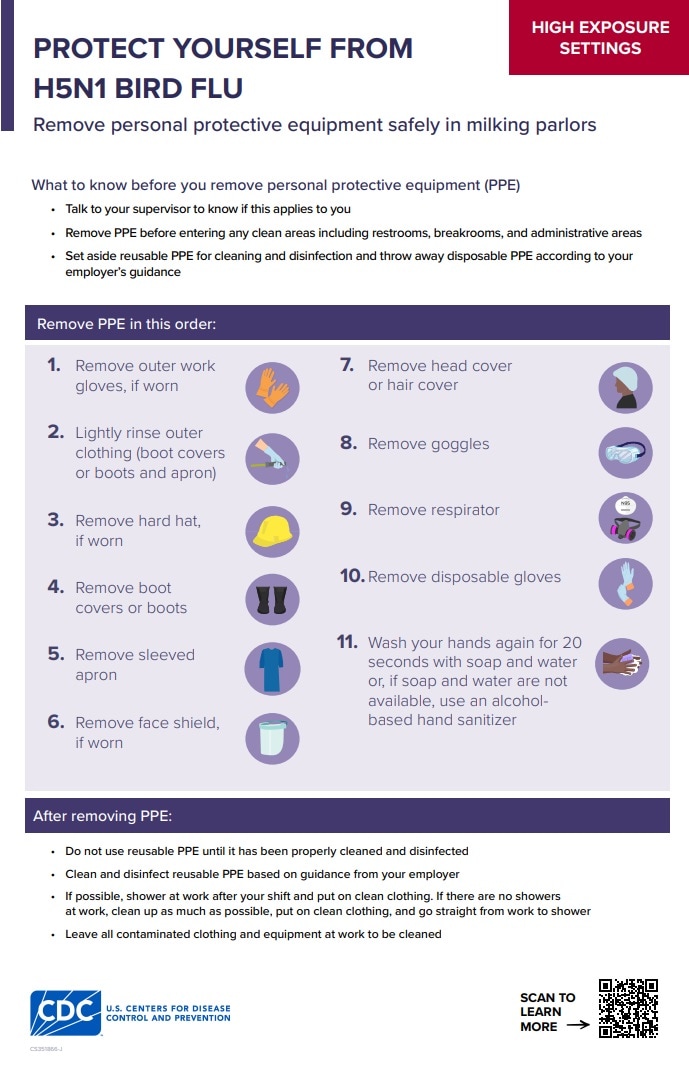
Remove Personal Protective Equipment Safely – High Exposure for Milking Parlor
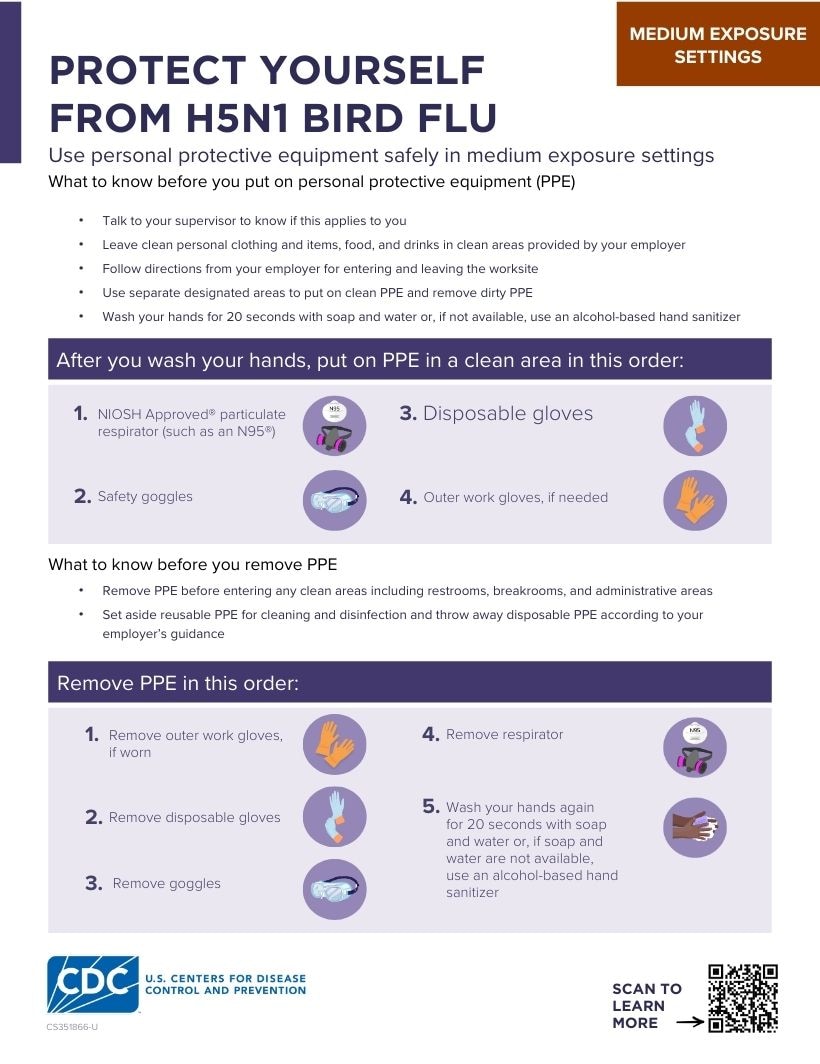
Know your rights
Federal law entitles you to a safe workplace. Your employer must keep your workplace free of known health and safety hazards. You have the right to speak up about hazards without fear of retaliation. See the Occupational Safety and Health Administration's Worker Rights and Protections page for more information.
